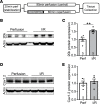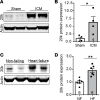Stress response protein GJA1-20k promotes mitochondrial biogenesis, metabolic quiescence, and cardioprotection against ischemia/reperfusion injury
- PMID: 30333316
- PMCID: PMC6237442
- DOI: 10.1172/jci.insight.121900
Stress response protein GJA1-20k promotes mitochondrial biogenesis, metabolic quiescence, and cardioprotection against ischemia/reperfusion injury
Abstract
Connexin 43 (Cx43), a product of the GJA1 gene, is a gap junction protein facilitating intercellular communication between cardiomyocytes. Cx43 protects the heart from ischemic injury by mechanisms that are not well understood. GJA1 mRNA can undergo alternative translation, generating smaller isoforms in the heart, with GJA1-20k being the most abundant. Here, we report that ischemic and ischemia/reperfusion (I/R) injuries upregulate endogenous GJA1-20k protein in the heart, which targets to cardiac mitochondria and associates with the outer mitochondrial membrane. Exploring the functional consequence of increased GJA1-20k, we found that AAV9-mediated gene transfer of GJA1-20k in mouse hearts increases mitochondrial biogenesis while reducing mitochondrial membrane potential, respiration, and ROS production. By doing so, GJA1-20k promotes a protective mitochondrial phenotype, as seen with ischemic preconditioning (IPC), which also increases endogenous GJA1-20k in heart lysates and mitochondrial fractions. As a result, AAV9-GJA1-20k pretreatment reduces myocardial infarct size in mouse hearts subjected to in vivo ischemic injury or ex vivo I/R injury, similar to an IPC-induced cardioprotective effect. In conclusion, GJA1-20k is an endogenous stress response protein that induces mitochondrial biogenesis and metabolic hibernation, preconditioning the heart against I/R insults. Introduction of exogenous GJA1-20k is a putative therapeutic strategy for patients undergoing anticipated ischemic injury.
Keywords: Heart failure; Ion channels; Metabolism; Muscle Biology; Translation.
Conflict of interest statement
Figures










Similar articles
-
GJA1-20k and Mitochondrial Dynamics.Front Physiol. 2022 Mar 23;13:867358. doi: 10.3389/fphys.2022.867358. eCollection 2022. Front Physiol. 2022. PMID: 35399255 Free PMC article. Review.
-
Protective mitochondrial fission induced by stress-responsive protein GJA1-20k.Elife. 2021 Oct 5;10:e69207. doi: 10.7554/eLife.69207. Elife. 2021. PMID: 34608863 Free PMC article.
-
GJA1-20k Arranges Actin to Guide Cx43 Delivery to Cardiac Intercalated Discs.Circ Res. 2017 Oct 13;121(9):1069-1080. doi: 10.1161/CIRCRESAHA.117.311955. Epub 2017 Sep 18. Circ Res. 2017. PMID: 28923791 Free PMC article.
-
GJA1-20k attenuates Ang II-induced pathological cardiac hypertrophy by regulating gap junction formation and mitochondrial function.Acta Pharmacol Sin. 2021 Apr;42(4):536-549. doi: 10.1038/s41401-020-0459-6. Epub 2020 Jul 3. Acta Pharmacol Sin. 2021. PMID: 32620936 Free PMC article.
-
GJA1-20k, a Short Isoform of Connexin43, from Its Discovery to Its Potential Implication in Cancer Progression.Cells. 2025 Jan 24;14(3):180. doi: 10.3390/cells14030180. Cells. 2025. PMID: 39936974 Free PMC article. Review.
Cited by
-
Peptidic Connexin43 Therapeutics in Cardiac Reparative Medicine.J Cardiovasc Dev Dis. 2021 May 5;8(5):52. doi: 10.3390/jcdd8050052. J Cardiovasc Dev Dis. 2021. PMID: 34063001 Free PMC article. Review.
-
GJA1-20k and Mitochondrial Dynamics.Front Physiol. 2022 Mar 23;13:867358. doi: 10.3389/fphys.2022.867358. eCollection 2022. Front Physiol. 2022. PMID: 35399255 Free PMC article. Review.
-
Sex as Biological Variable in Cardiac Mitochondrial Bioenergetic Responses to Acute Stress.Int J Mol Sci. 2022 Aug 18;23(16):9312. doi: 10.3390/ijms23169312. Int J Mol Sci. 2022. PMID: 36012574 Free PMC article.
-
Connexins in Cancer: Jekyll or Hyde?Biomolecules. 2020 Dec 10;10(12):1654. doi: 10.3390/biom10121654. Biomolecules. 2020. PMID: 33321749 Free PMC article. Review.
-
A microtubule-connexin-43 regulatory link suppresses arrhythmias and cardiac fibrosis in Duchenne muscular dystrophy mice.Am J Physiol Heart Circ Physiol. 2022 Nov 1;323(5):H983-H995. doi: 10.1152/ajpheart.00179.2022. Epub 2022 Oct 7. Am J Physiol Heart Circ Physiol. 2022. PMID: 36206047 Free PMC article.
References
Publication types
MeSH terms
Substances
Grants and funding
LinkOut - more resources
Full Text Sources
Medical
Research Materials
Miscellaneous

